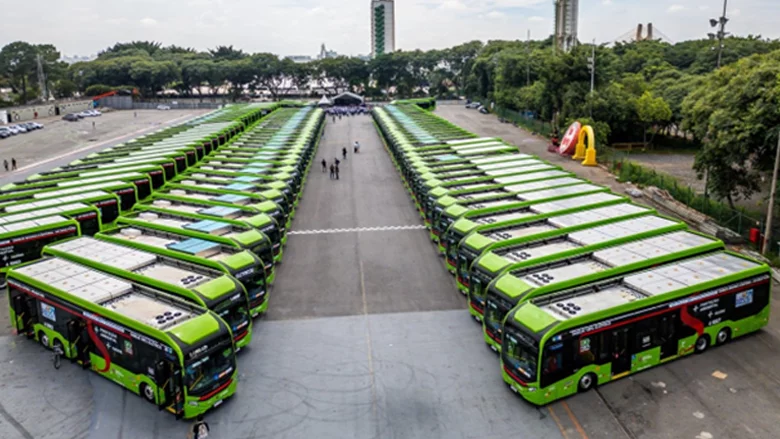Source: The Transport Politic

Photo: Chris Phan
A new bus rapid transit line opens near Eugene, Oregon as protesters argue against future investment.
With the rise of bus rapid transit and the increasing movement for better bicycling facilities have come a new form of community protest — a sense of indignation among some members of the affected areas about abandoning parts of the road that they had once assumed were to be entirely reserved for cars. From New York to Berkeley to Eugene, places more typically known for their liberal politics are becoming battle grounds over the right and wrong ways to use the street.
This week, Eugene’s Lane Transit District celebrated the opening of the $41 million, 7.8-mile Gateway EmX extension, a new BRT route that links downtown Springfield (a nearby town) with the Gateway Mall, the PeaceHealth medical complex, and other destinations. The first EmX (Emerald Express) route, a 4-mile $24 million link between downtown Eugene and downtown Springfield via the University of Oregon, opened in 2007.
From all outward appearances, Eugene is doing BRT just right. The new line has 60% of its right-of-way reserved for buses alone; it features extended buses with doors on both sides and commodious, neighborhood-integrated stations; it offers reliable and fast service every 10 to 15 minutes thanks to signal priority; customers can take advantage of level boarding and off-board fare collection; and it is very well routed, reaching the center of all the places it is meant to serve, not their margins as do so many transit corridors. In three years, ridership doubled and exceeded 20-year projections. Operations costs are low enough that the initial corridor may be profitable*.
For a medium-sized metropolitan area like that of Eugene, BRT of this sort makes for an ideal investment. The project could be completed more cheaply because the city agreed to allow the bus line to run in the center of the street. And more expensive technology, like light rail, would have likely provided unnecessary capacity for a medium-sized city like this**.
Nonetheless, the expansion of the EmX system has not been uncontested. Protesters from the west side of Eugene, where the next BRT corridor is supposed to go, have been fighting its construction for months. These opponents have suggested that the new $105 million line would hurt the nearby communities and lead to the elimination of jobs because it would reduce traffic throughput and require the acquisition of several residential and commercial properties.
The transit district expects to eventually construct up to 61 miles of EmX routes, crisscrossing the region on all of the major travel corridors.
The controversy over bus rapid transit in Eugene is the most recent of what has become a familiar meme in the annals of alternative transportation development. In New York, new bus rapid transit corridors and bike lanes have been accused of disrupting business and shutting down parking. In Berkeley, opponents have set their sights on a reserved bus right-of-way and argue that its construction will reduce retail activity, making regular commerce all but impossible. In Toronto, new Mayor Rob Ford has come out swinging against street-running light rail because he wants to end “the war on the car” imposed by the previous mayor, arguing that subway investments are more appropriate (and out of the way), despite their much higher costs.
These fears, however, have a lot more to do with the specter of disrupting the status quo than anything else. People who are used to have having all parts of the streets in their neighborhoods open to private vehicles at all times cannot imagine how it could possibly be a good idea to provide dedicated lanes for buses or for bikes. A recent New York Times editorial cartoon satirized this perception, raising the possibility that in the future every mode of transportation will get its own lane — except for the private automobile.
There is an alternative: Constructing transit rights-of-way out of the way of the street. Doing so, though, usually costs far more and is often less effective in connecting a community’s most vibrant districts. Thus the best option for transit investments — both in terms of cost-effectiveness and ridership growth — often requires taking space away from cars. That’s especially true in smaller metropolitan areas like Eugene-Springfield, which can do the most with the least amount of money if they choose to devote private automobile lanes to bus services.
For cities and transit agencies attempting to improve services in these budget-constrained times, keeping the communities along proposed new transit routes happy is essential. The argument in favor of dedicating lanes to buses or bikes must be a compelling one that ensures to a community that in exchange for lost car lanes and parking spaces, there will be an increase in traffic from people using non-automobile based modes. And the improvements must be good enough to convince the people along the routes that they will want to take advantage of them themselves.
Such arguments are not easy to make, but if a city wants to avoid — or at least subdue — conflict over transit improvements, it must engage them as strongly as possible. Otherwise, reasonable and cost-efficient investments like the EmX will be lost to squabbling.
* Operating costs, at $1.15/passenger, are lower than standard bus fare of $1.50/passenger.
** I should note that some have suggested that the initial line, with some of the corridor in one-lane sections, is not good enough to be real BRT. But with frequencies only every 10 minutes, the shared lane doesn’t pose much of a problem. And the transit agency has been able to reduce running times by more than 25% per trip — meaning something is being done right here. One concern is the new route’s loop segment along which alternating buses travel in either direction. This is a travel configuration that will likely confuse some users.
¿Comments? ¿Opinions? ¿Similar News? Send them to us!












